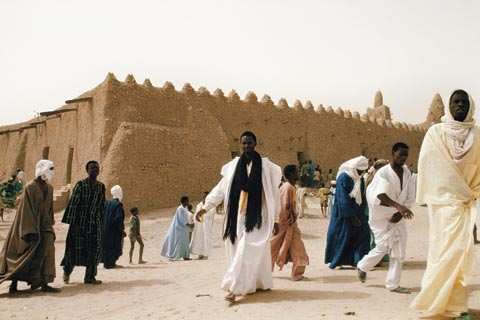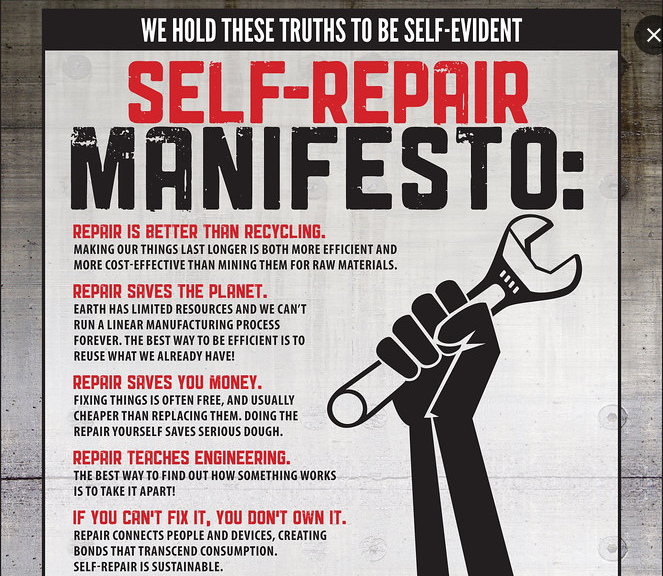


Female Education, Technologies and the Demographic Transition
16 March 2021
Is Innovation a Matter of Destruction and Creation?
16 March 2021A New Mandate for UN Peace Operations
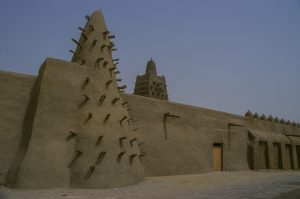
Djinguereber Mosque in Timbuktu, Mali -July, 2009. Crédits image : Iwanami Photo, Shutterstock
Following the destruction of World Heritage sites in Mali, Iraq, and Syria between 2012 and 2015, the UN Security Council implemented new measures. This UN body is now in a position to grant UN peace operations mandates to protect cultural property if it is threatened during an armed conflict. Recent Sciences Po PhD graduate Mathilde Leloup devoted her doctoral thesis to studying the complex causes of this phenomenon in ‘Redefining humanity through its heritage. The incorporation of cultural sites protection into peacekeeping mandates’. Awarded the Dalloz Prize in 2020, her work sheds light on issues that transcend the objectives stated in the thesis.
What was your objective in analysing the integration of the protection of cultural sites in the mandate of UN peace operations?
Mathilde Leloup: The idea was to demonstrate that the issue of cultural heritage, which is understudied in political science, provides a clear window into current tensions in multilateralism.
I wanted the thesis to underscore the exceptional nature of the crisis that UNESCO faced between 2012 and 2015 amid the systematic destruction of World Heritage sites. Beginning in June 2012, northern Mali was occupied by the terrorist group Ansar Dine, which destroyed the mausoleums and manuscripts of Timbuktu.
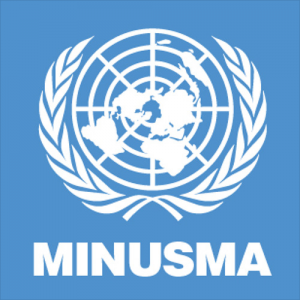
La Mission multidimensionnelle intégrée des Nations unies pour la stabilisation au Mali
The UN Security Council responded on April 25, 2013, by adopting resolution 2100, which entrusted the new UN peace operation in Mali (MINUSMA) with ‘protecting from attack the cultural and historical sites in Mali’. In 2015, the Islamic State destroyed the classified sites of Mosul, Hatra (Iraq) and Palmyra (Syria). The example of MINUSMA then became the basis for UNESCO’s forceful call for UN missions to systematically protect cultural heritage properties (monuments and archaeological sites). Two years later, resolution 2347 passed and established MINUSMA as a model for future peace operations.
After nearly a year of fieldwork at UNESCO’s headquarters in Paris and at the UN in New York, I came to the following conclusion: MINUSMA’s protection of cultural heritage went from being an isolated event to becoming an international cause because it elevated humanity – a notion that is as complex as it is appealing to international organisations. In law, humanity is traditionally considered both in terms of what threatens it – its enemies – and what it contains – a common heritage. Thus, the fact that terrorist groups systematically attacked World Heritage sites between 2012 and 2015 paradoxically made their protection appear as a ‘need of humanity’ and strengthened the role of certain actors (UNESCO among others) in the multilateral system.
What strategies were deployed to achieve this?
In a crisis situation, the emergence of a hero is enabled by the identification of perpetrators and victims. This hypothesis was born of the observation that the 2012–2015 crisis, during which World Heritage cultural sites were destroyed, was akin to the atmospheres of ‘moral panic’ and ‘moral euphoria’ analysed and conceptualised by Matthew Flinders and Matthew Wood(1)Matthew Flinders et Matthew Wood ‘From folk devils to folk heroes: rethinking the theory of moral panics’, Deviant behavior, Vol. 26, n° 8, 2015..

Djinguereber mosque in Timbuktu. Crédits image ; Berthold Steinhilber/laif/Redux
Moral panic leads to the emergence of an ’agent of social concern (group, community, individual) that is feared by society due to the presumed moral deviancy of its behaviour’(2)Ibid., 644). Meanwhile, moral euphoria is conducive to an “agent of social concern (group, community, individual) that is loved and held in awe by society due to the presumed moral fortitude of its behaviour
This opposition led me to the criminalisation/heroization/victimisation triptych. In order to claim the mantle of “defenders of humanity”, UNESCO (and at another level its Director General and some of its member states) identified the perpetrators of attacks on cultural heritage (criminalisation process). At the same time, they identified victims, i.e. populations experiencing the destruction of sites (victimisation process). This ultimately allowed them to emerge as the heroes in this crisis (heroization process).
You believe this process also serves UNESCO’s own policy objectives….
Yes, this three-pronged process actually reveals an instrumentalisation of the notion of humanity for political purposes among those who called for a systematic protection of cultural heritage in peace operations. Indeed, it provided them the opportunity to reposition themselves in the “hierarchy of multilateralism” while paradoxically cloaking all their actions under the “enchanted veil of apoliticism” described by Jacques Lagroye((Jacques Lagroye (dir.), La politisation, Belin, 2003, p. 371..
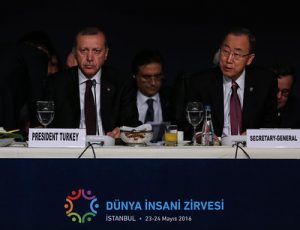
Istanbul, May 2016: Recep Tayyip Erdogan and Ban Ki-moon at World Humanitarian Summit. Crédits photo : OCHA / Salih Zeki Fazlıoğlu. CC BY-ND 2.0
It thus enabled UNESCO, hobbled since its creation in 1945 by the absence of an operational mandate, to be recognised as a “humanitarian actor” (in the same way as the UNDP and UNICEF) at the 2016 World Summit on Humanitarian Action in Istanbul. It also gave the Director-General at the time, Irina Bokova (2009–2017), the opportunity to appear as a credible candidate to succeed Ban Ki-moon as UN Secretary-General during her 2016 campaign. Finally, it made it easier for some states, such as Italy, to obtain a non-permanent seat on the Security Council.
What specific areas did you explore in this work?
Mathilde Leloup: I used three types of approaches: participatory observation in international organisations, semi-structured interviews, and archival analysis. For seven months, I conducted participant observation at the UNESCO Secretariat in Paris, as a trainee in the Department of Public Information, then as a consultant in the Office of the Director-General. I continued this observation for three months as an intern on the Civil Affairs Team of the Policy, Evaluation and Training Division of the UN Department of Peacekeeping Operations in New York. I supplemented these observations with 80 semi-structured interviews with UNESCO and UN officials working in the secretariats and in the field, particularly in Mali, Iraq and Syria. I also interviewed officials from other organisations such as NATO and some armies, notably the French and American ones. Finally, I conducted an analysis of UN and UNESCO archives to document the existence of peace operations prior to MINUSMA that had included the protection of cultural sites, such as the one in Kosovo (MINUK).
What is the focus of your current work?
Mathilde Leloup: Thanks to the academic partnership between the University of Oxford and Sciences Po, I am conducting postdoctoral research under the supervision of Richard Caplan, in the Department of Politics and International Relations (DPIR) of the University of Oxford. My objective is to analyse the symbolic significance of cultural heritage in current asymmetrical conflicts (Mali, Iraq, Syria). Indeed, between 2012 and 2015, the systematic destruction of cultural heritage became part of the “strategic communication” of certain terrorist groups, be it Ansar Dine in Mali or the Islamic State in Iraq and Syria.
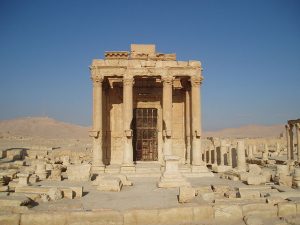
Temple of Baal Shamin, Palmyre, Crédits photo ; E.jaser, Public domain, via Wikimedia Commons
In response to this new strategy, many regular armies forming the contingents of uni- or multilateral operations (under NATO or UN command) took initiatives to protect cultural property. These initiatives were then publicised as part of their own “strategic communication”.
My research seeks to answer two key questions: why does cultural heritage become a strategic component of belligerents’ communication in the context of asymmetric wars? Under what conditions can the symbolic value of cultural heritage represent a strategic asset for military institutions?
My hypothesis is as follows: the role of cultural heritage in conflict situations is often reduced to that of an apolitical target, be it the victim of “collateral damage” in the case of regular armies, or of “intentional destruction” in the case of terrorist groups. In reality, however, it is a political tool for delegitimising the adversary and legitimising oneself: through protective actions for some and destructive actions for others. At a time of asymmetrical wars, this instrumentalization of cultural sites is even more significant given their extremely powerful symbolic dimension. In other words, my research reflects on the relationship between military institutions and the cultural dimension of their theatres of operation.
You are an associate doctor at CERI. Are you pursuing any specific projects in the context of this association?
Mathilde Leloup: For the past three years, I have been co-organising the monthly seminar of the Research Group on Multilateral Action (GRAM) at CERI with Guillaume Devin and Sarah Tanke. This transdisciplinary seminar is rooted in a socio-historical perspective and aims to present the contemporary challenges of multilateralism, such as the environment, globalisation, and transnationalization. It also aims to foster debate between academics and practitioners from international organisations, embassies, and NGOs. In February 2020, the GRAM became a Research Group (GdR) and I was entrusted with the coordination of the “Multilateralism Observatory” project with several colleagues. This project will monitor issues covered by international organisations (notably the environment, culture, etc.). I will lead the “cultural multilateralism” cluster monitoring cultural issues in international organisations, including, for example, the protection of cultural heritage in emergency situations, and the contribution of cultural industries to sustainable development goals.
Interview by Miriam Perier, CERI
Mathilde’s thesis was co-supervised by Frédéric Ramel (Sciences Po/CERI) and Dacia Viejo-Rose (University of Cambridge/McDonald Institute). It has been the subject of several publications, including the article “Heritage protection as stabilisation: the emergence of a new ‘mandated task’ for UN Blue Helmet” published in the journal International Peacekeeping in March 2019, and the article “Negotiating the expansion of security at the UN: the protection of cultural heritage by peacekeeping operations”, published in the journal Négociations in March 2021. After winning the Éditions Dalloz award, her thesis will be published on 21 April 2021 by this publisher under the title Defending Humanity by Protecting its Heritage, a New Mandate for UN Peace Operations.
Notes
| ↑1 | Matthew Flinders et Matthew Wood ‘From folk devils to folk heroes: rethinking the theory of moral panics’, Deviant behavior, Vol. 26, n° 8, 2015. |
|---|---|
| ↑2 | Ibid., 644). Meanwhile, moral euphoria is conducive to an “agent of social concern (group, community, individual) that is loved and held in awe by society due to the presumed moral fortitude of its behaviour
This opposition led me to the criminalisation/heroization/victimisation triptych. In order to claim the mantle of “defenders of humanity”, UNESCO (and at another level its Director General and some of its member states) identified the perpetrators of attacks on cultural heritage (criminalisation process). At the same time, they identified victims, i.e. populations experiencing the destruction of sites (victimisation process). This ultimately allowed them to emerge as the heroes in this crisis (heroization process). You believe this process also serves UNESCO’s own policy objectives….Yes, this three-pronged process actually reveals an instrumentalisation of the notion of humanity for political purposes among those who called for a systematic protection of cultural heritage in peace operations. Indeed, it provided them the opportunity to reposition themselves in the “hierarchy of multilateralism” while paradoxically cloaking all their actions under the “enchanted veil of apoliticism” described by Jacques Lagroye((Jacques Lagroye (dir.), La politisation, Belin, 2003, p. 371. |

